•New Database Configuration - Synergy W700A
•New Database Configuration - Synergy W700B
•Counter Signatures (W701 Only)
Follow this Section if this is a new installation of Synergy.
After the Synergy installation is completed and the Server has been rebooted, use the SynergyConfiguration Utility (SynergyConfig) to create and initialise the Synergy database.
| Note: | To run SynergyConfig, the User must be an Administrator on the Local machine. |
| Also, if configuring a Synergy W700B install; either the User’s Windows login must map to a sys admin role on the SQL Server or the User must able to login to an SQL account with the sys admin role on the target SQL Server. |
1.To access the SynergyConfiguration Utility, navigate to:
Windows Start menu > All Programs > Hanwell Instruments Ltd> SynergyConfig
•If the host machine has User Account Control enabled then the User Account Control window will be displayed. See Figure 54 below:
Figure 54
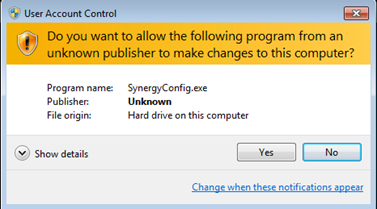
2.Click Yes.
•The Synergy Services window is displayed, stating that services will be stopped while SynergyConfig is running. See Figure 55 below:
Figure 55
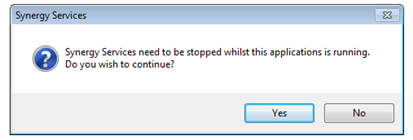
•If the host machine does not have User Account Control enabled, the User Account Control window will not appear and the procedure will go straight to the Synergy Services window stating that services will be stopped while SynergyConfig is running. See Figure 55 above.
3.Click Yes.
•Another message will be shown stating that it can take up to a minute for the active services to be stopped.
4.Click OK.
| • | The SynergyConfiguration Ver: x.x.x.x window is displayed. See Figure 56 below: |
Figure 56
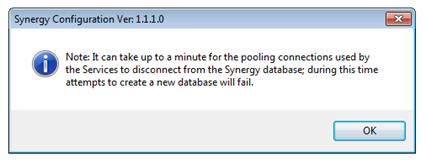
5.Click OK.
| • | The Synergy Data Service window is displayed telling you NOT to attempt to start any of the Synergy services whilst SynergyConfig is running. See Figure 57 below: |
Figure 57
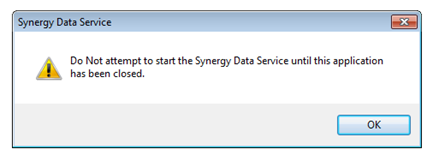
6. Click OK.
| • | A series of windows will be displayed as the SynergyConfiguration Utility searches for SQL Servers; this may take some time. |
| Note: | You may find that Synergy services will be stopped during the period that the SynergyConfiguration Utility is open. |
| Do not try to restart any services during this period; all services will restart themselves once the SynergyConfiguration Utility is closed. |
New Database Configuration - Synergy W700A
Synergy W700A must use an SQL Server on the Local machine which should appear at the top of the SQL Server: drop-down list. See Figure 58 below:
Figure 58
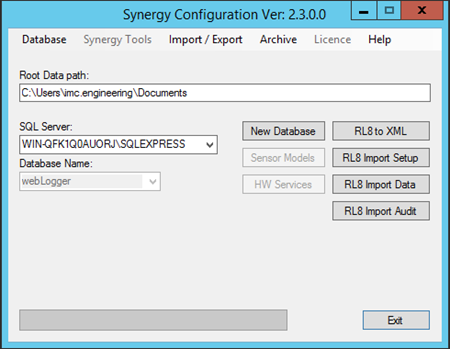
New Database Configuration - Synergy W700B
Synergy W700B can use an SQL Server on either the Local machine or another machine on the LAN.
The SQL Search function will only work if SMO components have been installed as part of an SQL Server or SQL Server Manager Studio installation on the Local machine.
If SQL Servers are shown in the SQL Server: drop-down list, continue at SQL Servers Shown.
•Typical SQL Servers shown above.
Synergy W700B - No SQL Servers Shown
If no Servers are shown in the SQL Server: drop-down list. See Figure 58 above.
1.Select the Manual Connection menu item from the Database menu. See Figure 59 below:
Figure 59
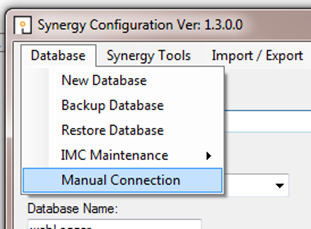
•This will display the Manual Connection dialog box. See Figure 60 below:
Figure 60
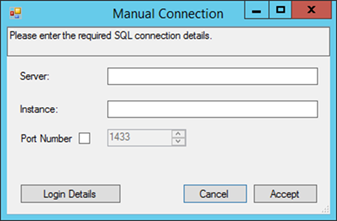
2.In the Manual Connection dialog, enter the required SQL Server machine name and, if required:
Either:
Enter an SQL Server Instance name into the Instance: field.
Or:
Tick the Port Number box and enter a Port Number, either directly or by advancing the displayed number up or down using the box’s arrows.
3.Click Login Details to display the SQL Administrator Account dialog box. See Figure 61 below:
Figure 61
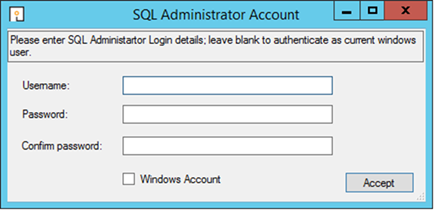
•Generally Windows Account should be selected to use a Windows integrated login. However, if necessary a SQL Username and Password can be entered in the appropriate text fields.
4.Click Accept to return to the Manual Connection dialog box.
5.Click Accept on the Manual Connection dialog box to continue.
•The Config Utility application will now test the SQL connection details.
•If the test is successful, Figure 62 below will be displayed:
Figure 62
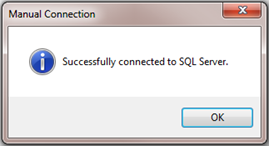
6.Click OK and continue at Creating a New Database below.
•If the test is unsuccessful, Figure 63 below will be displayed:
Figure 63
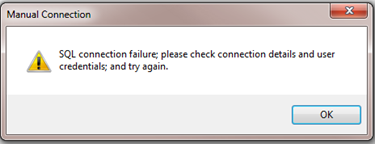
In this instance:
| • | Check your connection and login details and retry. |
If you are sure that your connection and login details are correct and the process still fails:
| • | Check all associated Firewall settings. |
| • | Check that the SQL Server is configured to accept remote connections. |
| • | Check that a connection can be routed from the Synergy Server to the SQL Server. |
If you are unsure how to do this, ask your System Administrator or IT support provider for assistance. Please do NOT ask IMC for assistance until you have established that an SQL connection can be made from the Synergy Server to the SQL Server.
•If the required SQL Servers are shown, select the required SQL Server instance from the drop-down list. See Figure 64 below:
Figure 64
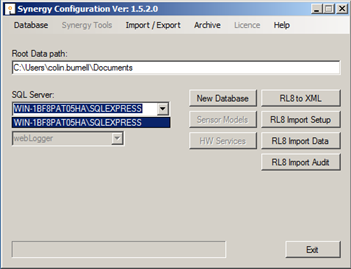
| • | If the required SQL Server is not shown, check Firewall settings on the local and SQL Server machines and make sure that the SQL Server Browser service is running on the SQL Server. |
W700B Remote SQL Server
If connecting to an SQL Server on another machine on the LAN, the SQL Administrator Account login dialog box may appear. See Figure 65 below:
Figure 65
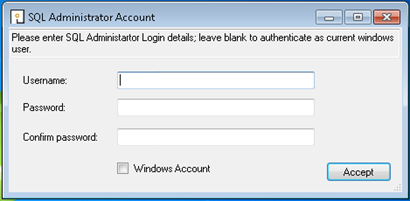
| • | If the Users Windows login maps to a Sys Admin role on the SQL Server: |
i.Leave the Username: and Password: boxes blank.
ii.Select the Windows Login checkbox.
iii.Click Accept to continue.
| • | If the Users Windows login DOES NOT map to a Sys Admin role on the SQL Server: |
i.Enter the Username and Password for the required SQL Sys Admin account.
ii.Make sure the Windows Login checkbox is de-selected.
iii.Click Accept to continue.
1.Click New Database on the main dialog box. Figure 64 above.
| • | The Product Sector window is displayed. See Figure 66 below: |
Figure 66
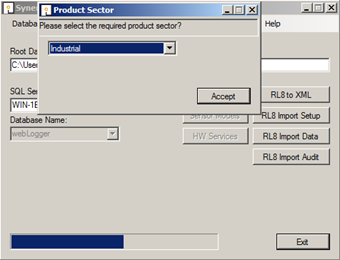
2.Select the sector relevant to the Customer, Heritage, Industrial, Pharmaceutical or Healthcare from the drop-down menu.
3.Click on Accept.
The Company Details window is displayed.
4.Complete the Company Details form. See Figure 67 below:
Figure 67
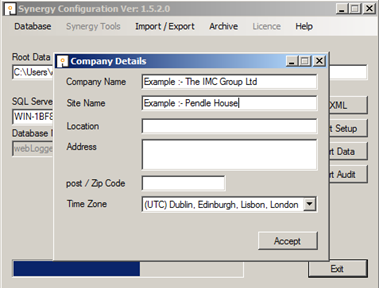
| • | Set the Time Zone to the time zone of the Site. |
| • | The default value displayed will be the time zone used by the host PC. |
| • | It is important that this is set correctly, as dates in the database are stored using GMT. |
| Note: | Users entering address data should adhere to local data protection requirements and regulations. |
5.Click Accept.
•The IMC Listen Port window is displayed. See Figure 68 below:
Figure 68
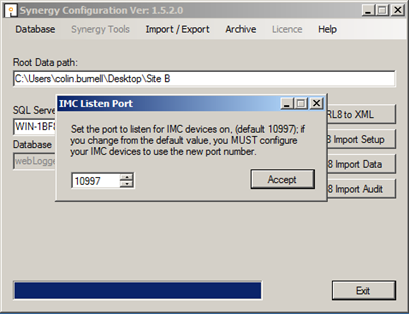
6.The Port Number of the port used to listen for IMC devices - Selsium Receivers, IMC ARB Modules and IMC SMS Modules needs to be entered; the Default Port Number is 10997.
If the default Port Number is unavailable, enter the required Port Number, remembering that you must configure all IMC base type devices to use the Port Number set here.
7.Click Accept.
If the Synergy database has been created successfully, the New Database window will be displayed. See Figure 69 below:
Figure 69
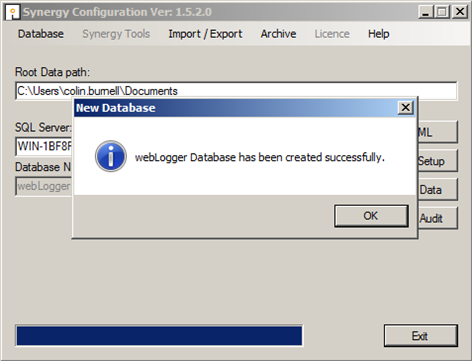
8.In the SynergyConfiguration Ver x.x.x.x window, click on the Sensor Models button.
•This will import the entire range of Hanwell sensor types into the database.
Once this process is complete, the message shown below in Figure 70 will be displayed stating that the Sensor Model tables have been created successfully.
Figure 70
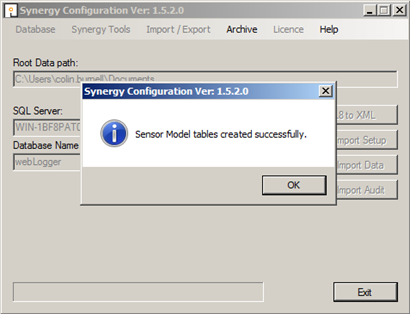
9.Click HW Services.
The Hardware Service window is displayed. See Figure 71 below:
Figure 71
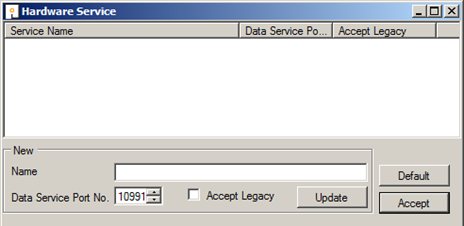
10.Click Default and three Hardware Services will be selected, as in Figure 72 below:
Figure 72
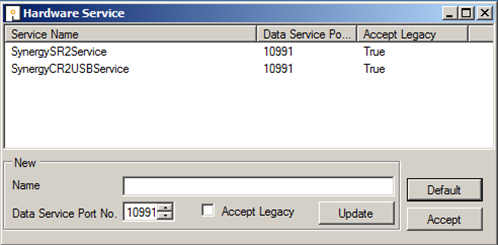
11.Click Accept.
| • | This will import the Hardware Services to the database, allowing for certain types of hardware to be functional within Synergy. |
| • | The Hardware Services window will close after the import has taken place. |
12.Select Reports Folder from the Synergy Tools menu entry in the SynergyConfiguration Ver x.x.x.x window. See Figure 73 below:
Figure 73
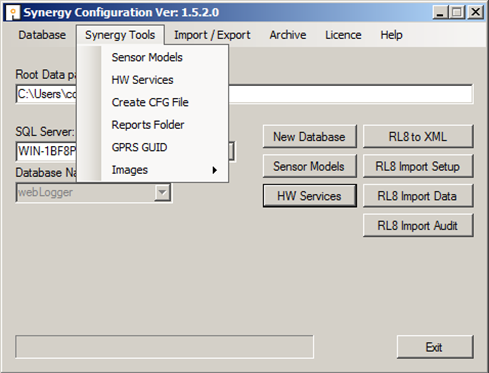
•The Reports Folder window is displayed stating that the permissions will need to be changed (automatically) to enable the services to write to this location. See Figure 74 below.
| • | The Reports Folder is where Synergy stores copies of the Scheduled Reports which Synergy Users can set up and run. |
Figure 74
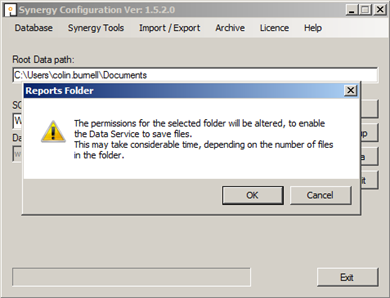
13.Click Ok.
14.The next step in the procedure is to decide on a location that generated reports will be saved on the host network.
Either:
Select an existing location from the list displayed in the displayed Browse For Folder window. See Figure 75 below:
Figure 75
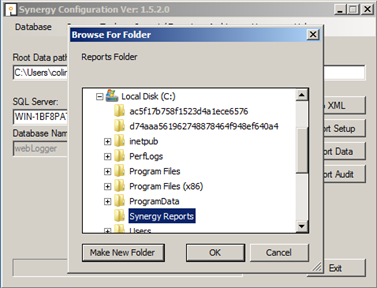
Or:
i.Select a location from the list displayed in the Browse For Folder window.
ii.Click on the Make New Folder button to create a new folder.
iii.Enter a name for the new folder in the highlighted box.
15.Once the location has been decided and selected, click OK.
Counter Signatures (W701 Only)
With W706 Validated Synergy installed, and a W701 Licence applied to it, you will have Counter Signatures applied to your system.
You have the ability to turn off the Counter Signatures using the SynergyConfig utility.
By default, the Counter Signatures are turned on, but if you would like to turn them off, follow the instructions below:
| • | While in SynergyConfig, select W701 Counter Signatures from the Synergy Tools menu, |
| • | Once selected, you will be asked to confirm that you would like to turn them off. |
| • | To turn Counter Signatures back on, you can follow the same steps. |
